How to Resolve Disputes on Blockchain-Powered Platforms & Approach Governance Models?
In the rapidly developing public chain and dApp landscape, decentralized governance and dispute resolution has emerged as the key missing piece to protecting users’ rights and assets and driving user adoption.
In short, blockchain security should have two layers: (1) cybersecurity and (2) governance. Although the focus tends to be on cybersecurity, regular users encounter conflicts/disputes more often than security hacks in their day-to-day usage, making governance just as important as cybersecurity. This is even more true in decentralized ecosystems that do not (or should not) have centralized arbitration services.
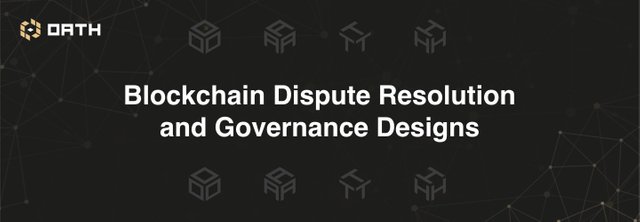
In this article, we want to examine different approaches to blockchain governance and dispute resolution and compare them with what we’re building here at Oath.
ECAF
The EOSIO Core Arbitration Forum

The EOSIO Core Arbitration Forum, or ECAF, is established by the EOS Constitution. Here is the specific language that mentions ECAF:
All disputes arising out of or in connection with this Constitution shall be finally settled under the Rules of Dispute Resolution of the EOS Core Arbitration Forum by one or more arbitrators appointed in accordance with the said Rules.
The ECAF is comprised of vetted arbitrators, trained to consider the special context of blockchain disputes. The arbitrators have to meet certain criteria, including fluency in English and minimum education level, and complete an apprenticeship training process, in which they are mentored by a more experienced arbitrator, before being allowed to rule on a dispute in their own right. Currently, there are six arbitrators who have been cleared to arbitrate mostly complex cases, which are then executed by EOS block-producers (BPs).
By default, one arbitrator is appointed to decide the case. Appeals and disciplinary cases are heard by a panel of three, led by a senior arbitrator. In exceptional circumstances, the (single) arbitrator may request the appointment of two additional arbitrators.
To review and arbitrate a case, ECAF charges a nonrefundable filing fee, paid by the claimant. The minimum fee is 6 EOS, for disputes valued at 1–250 EOS, and goes up to 7,560 EOS for claims valued at 5,000,000+ EOS. At the current exchange rate of USD ~$5.70/EOS, the minimum filing fee equals USD ~$34.20. For cases with no immediately calculable monetary damages, the default filing fee is 150 EOS (USD $855). The final arbitration cost is decided by the arbitrator and takes into account the arbitrator’s fees and expenses, the costs of experts and translators, and any other costs related to the conduction of the case.
What is the difference between ECAF and Oath Protocol?
- While ECAF’s jurisdiction is limited to the EOS chain, Oath Protocol provides a scalable and chain-agnostic solution that is compatible with any public chains and dApps. This also allows us to tap into the entire blockchain ecosystem to grow our juror community.
- ECAF imposes a minimum arbitration fee that varies depending on the value of the case at issue, whereas Oath uses the free-market principle, allowing the disputing parties to set juror awards.
- ECAF sets strict criteria for potential arbitrators. At Oath, practically anyone can become a juror after completing our community-led KYC process to establish identity and assign attributes, and our credit level system will differentiate among jurors with differing experience and expertise levels to ensure appropriate juror selection for cases of varying complexity.
Kleros
The Blockchain Dispute Resolution Layer

Kleros is a dispute resolution protocol, built on Ethereum, that works as a decentralized third party to arbitrate contract disputes. It “relies on game theoretic incentives to have jurors rule cases correctly.”
Kleros is an opt-in court system, comprised of the General Court and specialized courts and sub-courts. Each token holder (and potential juror) can register in at most one sub-court of each specialized court where they have activated their token during the sign-up. This ensures that jurors self-select the specialized courts they believe they are most skilled at.
The arbitration fees are determined by the sub-courts. Once the dispute is initiated, disputants deposit the fees in the smart contract, and failure to do so results in a default judgment in favor of the depositing party. At the conclusion of the case, the losing party pays the arbitration fees, and the other deposits are refunded.
Kleros implements a staking incentive as their juror reward mechanism.
This means two things: (1) the more tokens a potential juror deposits in the sub-court, the more likely he is to be selected to decide cases, and (2) at the conclusion of the case, the losing jurors’ staked tokens are distributed to the winning jurors who correctly voted for the winning party. In addition to receiving the losing jurors’ tokens, the winning jurors also receive the arbitration fee.
Kleros allows unlimited appeals, but disincentivizes them by automatically “doubling plus one” the number of jurors on each follow-up appeal, which exponentially increases the fees.
What is the difference between Kleros and Oath Protocol?
- Kleros requires its jurors to hold and stake the native platform tokens, whereas anyone can become an Oath Protocol juror, no token required.
- Kleros’s staking and re-distribution incentive system may prevent tentative jurors from voting (and risk losing their staked tokens), thereby lowering the overall participation rate. Oath’s positive incentive system, combined with juror reputation system, ensures a robust and high-quality juror pool.
- All actions on Kleros occur as on-chain transactions. This means two things: (1) Kleros will depend on technological milestones to solve scalability on the Ethereum network and (2) the cost of dispute resolution on Kleros will depend on gas fees needed to record those transactions. As a semi-off-chain solution that requires only two on-chain transactions (dispute initiation and recording of result), Oath can scale right away and manage high traffic as well as maintain relatively low gas fees.
- In contrast to Kleros’s unlimited appeals, Oath Protocol allows two appeals, keeping the same number of jurors, but selecting more experienced jurors with higher credit levels for subsequent appeals.
Aragon
Democratizing Governance
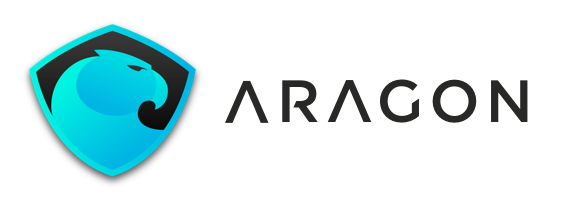
Aragon aims to “be the first community governed decentralized organization whose goal is to act as a digital jurisdiction, an online decentralized court system that isn’t bound by traditional artificial barriers such as national jurisdictions or the borders of a single country.”
The arbitration mechanism requires an individual that has a dispute to open a case and post a bond. The bond will be locked for the period of the arbitration process and returned if the case is resolved in the applicant’s favor. If not, the bond will be kept as a “network reserve.”
When the arbitration begins, five judges will be randomly selected from a pool of volunteers. Volunteers are individuals that have posted a bond indicating their interest in serving as a Judge. The five selected judges will vote on the outcome of the case.
If the applicant is unsatisfied with the ruling, he or she has the option to appeal by posting an even larger bond than before. For the appeal round, all the judges of the Aragon Network will be able to participate. If the applicant is still unsatisfied, there is the Supreme Court of the Aragon Network Jurisdiction, where the judges will be composed of the top 9 judges by ANJ payout. In other words, these are the individuals with the highest ranking in resolving Aragon Network Jurisdiction cases. The judges of the previous round will get rewarded or penalized according to the ruling of the Supreme Court. If they agree with the previous round’s judges, the judges from that round will be rewarded. And in the opposite decision, the judges of that round get penalized for a call that was overturned.
Currently, Aragon is still investigating the most efficient arbitration criteria for its platform, and the above framework is subject to change.
What is the difference between Aragon and Oath Protocol?
- Aragon implements a bond (i.e., staking) system to select case jurors, whereas anyone can be a juror on the Oath Protocol platform.
- Aragon uses a group of five judges to resolve first-instance disputes. Oath Protocol allows the disputing parties to select the number of jurors, with a minimum set at eleven, to ensure a more decentralized and fair process.
- Aragon’s five-person jury is selected randomly, whereas Oath Protocol relies on computing algorithms and party input to create diverse and fair juries.
- Aragon does not appear to set time limits on juror deliberation and dispute resolution process. On Oath Protocol, the entire process takes eight days, start to finish.
- Aragon Network Jurisdiction appears to be designed for dispute resolution within the Aragon Network. Oath Protocol is a a scalable and chain-agnostic solution that is compatible with any public chains and dApps via APIs.
JUR
Justice as a Service on the Blockchain

Jur proposes a dispute resolution system that utilizes blockchain technology to instill transparency and immutability in the legal industry. Jur’s dispute resolution solution uses a series of smart contracts to provide an incorruptible decentralized oracle that delivers fair and fast dispute resolution at near zero cost.
To participate in dispute resolution, voters on the Jur platform will need to stake tokens in a smart contract. Voting is therefore restricted to JUR token-holders, which is meant to incentivize outsiders to purchase the token.
Jur provides two different models of voting: open votes or closed Hub votes. Users can choose to enter their contracts in the open dispute resolution or any closed Hub in the Jur ecosystem.
In open votes, any voter can choose to participate. Although there is no centralized barrier to entry, rational voters will only choose to vote when they are more than 50% confident that they can predict the majority position, or else they risk losing their staked tokens.
In closed Hubs, only certain voters are allowed to vote. Admins can establish Hubs with requirements that Oracles must meet in order to vote, creating an ecosystem in which Hubs with vetted oracles are in competition to provide the best service. Hubs do not charge fees directly. Hub administrators earn revenue by selling the contracts that are used on the Hub.
Built on Ethereum, Jur depends on the further development of the technology as it relates to scalability. Presently, Jur is considering the implementation of side-chains, modeled on Loom or Raiden Network, for example.
Jur is available to third parties via APIs for a monthly subscription fee, making it less likely to become the standard industry solution.
What is the difference between Jur and Oath Protocol?
Built on Ethereum, Jur depends on solving the scalability dilemma and is actively researching alternative solutions, such as side chains. Oath Protocol offers a semi-decentralized solution, where only two transactions are recorded on-chain (case initiation and resolution), allowing for immediate scalability.
Jur charges third parties monthly subscription fees to use their APIs and refer disputes to the Jur Platform. Oath Protocol charges a one-time implementation fee for partner integration via APIs.
Jur’s staking system is intended to prevent tentative jurors from voting, thereby increasing vote confidence level, but lowering the overall participation rate. Oath’s juror incentive system, combined with juror reputation system, ensures a robust and high-quality juror pool.
The Jur jury pool is limited to JUR token holders. With Oath Protocol, anyone can become a juror, which allows us to create a large and more diverse jury pool.
Mattereum
Smart Contracts for the Real World
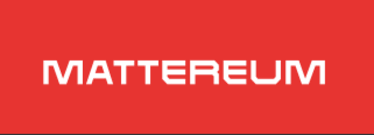
Mattereum is an “Internet of Agreements” project to manage legal rights over physical property, intellectual property, and eventually even real estate, on the blockchain. It combines smart contract engineering and legal expertise to enable legally enforceable digital agreements or, in other words, pair the smart contract code with a written legal contract. In parallel, part of this project is to build the ecosystem on the other side of this infrastructure, including mechanisms for ensuring that disputes are handled by suitably equipped dispute resolution professionals.
What is the difference between Mattereum and Oath Protocol?
- Mattereum is building a platform for creating legally enforceable blockchain-based contracts, linked to an arbitration panel for dispute resolution. Oath Protocol is building a layer 2 infrastructure to resolve disputes through a decentralized community.
- Mattereum will create a decentralized, international panel of independent, technically competent arbitrators for dispute resolution. Oath Protocol relies on a diverse jury pool of regular blockchain users.
- Mattereum contracts will interface with a system for selecting and appointing an arbitrator, who will then be able to give a binding ruling on any disputes that arise. Oath Protocol will use computing algorithms to select a jury of at least eleven peers to resolve factual disputes, leaving execution to our partner dApps and chains via smart contracts.
Oath Protocol
Decentralized Governance and Dispute Resolution
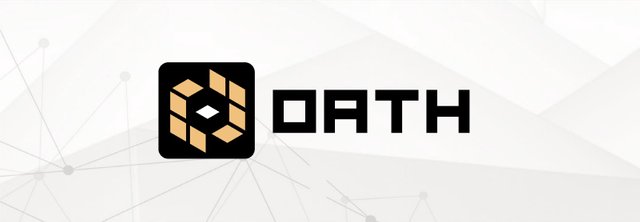
Oath Protocol is a blockchain dispute resolution and governance protocol. Modeled on the common law jury system, it combines one of the most reliable legal systems from the real world with blockchain technology, cryptography, and other concepts to provide a layer 2 cross-chain infrastructure for a decentralized, standard, and extensible public chain-agnostic protocol that protects dApp users’ rights and assets.
What are some of the key features of Oath Protocol?
- Community decisionmaking: Oath Protocol relies on regular blockchain users to form its juror community and decide cases. Jurors do not need to hold OATH tokens to qualify for juries (no staking), therefore eliminating concentration of power and potential for improper control of the platform. Larger juries (minimum of 11 jurors) more accurately represent community consensus and ensure decentralized decisionmaking.
- Semi-decentralized voting process: only two transactions take place on-chain (and require gas fees to record): initiation of the case and recording of the case result. The evidence submission and voting take place off-chain, facilitating more robust case participation by the jurors and eliminating gas fees associated with fully on-chain voting.
- Layer 2 protocol: as an infrastructure layer, Oath Protocol does not have to solve the problem of enforcing case decisions. When chains or dApps use a smart contract that incorporates Oath, once the case is decided, the outcome is returned to the smart contract, which then self-executes.
- Algorithms and safeguards to ensure fairness: Oath’s dynamic allocation algorithm reduces the odds of the same jury members resolving multiple disputes to avoid collusion, and the categorized random algorithm, designed for reducing bias, selects jurors with diverse backgrounds to ensure fairness. The jury members’ identities are kept confidential through cryptographic techniques to ensure objectivity.
- Compatibility with any public chains or dApps: via APIs, Oath Protocol is compatible with any chains or dApps, and our smart contract template library allows easy integration.
- Credit level system and data analytics: Oath’s credit level system and token reward mechanism incentivize good-faith decisionmaking and protect the ecosystem from bots and bad actors. Oath will also collect and analyze data relating to jurors’ behavior to enable our selection algorithms to select the best jurors for cases.
- Scalability and tiers: Because users are not required to have specialized expertise to become jurors, the jury community can grow significantly. The credit level system will reflect the jurors’ decisionmaking reputation. For complex or high-impact cases, Oath will be able to select top-tier jurors with the highest credit levels. For simplest cases, Oath may use a broader juror pool, with no minimum credit level requirement.
- Transparency: Oath Protocol saves the jurors’ votes and stated reasons therefor on the blockchain to create an immutable and searchable record.
In Summary
Each project takes different approaches to jury selection, voting, recording of transactions, and juror incentives. In all cases, the goal is to create a system that is fair to users and incentivizes good decisionmaking by the jurors. Kleros, Aragon, and Jur all require their jurors to hold and stake tokens to be selected to decide cases, whereas anyone can be a juror on the Oath Protocol Platform, and our juror credit level system incentivizes good decisionmaking and inhibits bad actors.
Both Oath and Kleros intend to be used as a layer 2 solution for other chains and dApps, and Aragon and Jur are working on independent, self-contained platforms. Only Oath Protocol offers a semi-decentralized solution, whereby only two transactions are recorded on-chain, which reduces gas fees and offers immediate scalability, not tied to the scalability limitations of the Ethereum network.
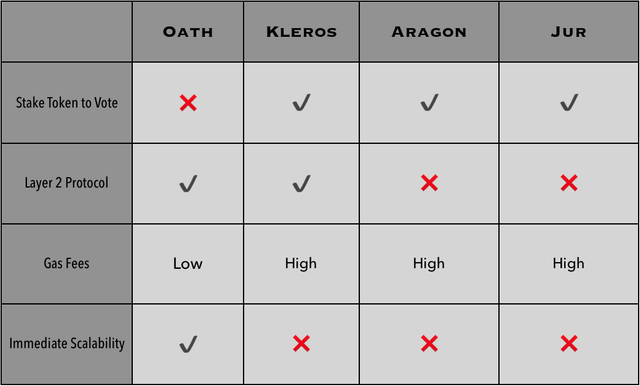
As with any protocol, the value will ultimately come from the users’ trust and use, and the ability to remain robust and relevant in an ever-evolving ecosystem.
With Oath Protocol, we have decided to uniquely focus on low-value/high-volume disputes in a semi-decentralized way that allows us to maintain scalability while preserving a fair and robust community decision making process.